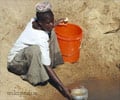The World Health Organisation unveiled Tuesday landmark new measures to counter the misuse of anti-malaria drugs, which is threatening attempts to stifle some 250 million cases a year of the disease.
The World Health Organisation unveiled Tuesday landmark new measures to counter the misuse of anti-malaria drugs, which is threatening attempts to stifle some 250 million cases a year of the disease.
The UN health agency recommended that all suspected cases of the mosquito-borne disease should be tested and diagnosed before treatment is given, instead of relying simply on identifying symptoms such as fever.It also unveiled its first ever procurement guidelines for anti-malarial medicines, to expand combination or multiple drug therapy and halt single drug use that is helping the parasite develop resistance to the new treatment artemisinin.
"It is critical that we work with countries to procure high quality medicines, because the use of medicines with sub-standard quality -- counterfeits and monotherapies -- is terribly dangerous," said Robert Newman, director of the WHO's global malaria programme.
"There is likely no greater global threat to the future success of malaria control than resistance to artemisinin," he told journalists.
Some 865,000 die each year from the debilitating mosquito-borne disease -- 85 percent of them children -- predominantly in Africa and Asia, according to the WHO.
At the moment, just 22 percent of suspected cases in some of the most affected African countries are properly diagnosed.
Advertisement
"Just a few years ago that proportion was five percent. It shows how far we have to go, but there has been quadrupling in a few years," he added.
Advertisement
More than one-third of 108 malaria-affected countries have managed to cut malaria cases by half since 2000, according to a WHO report released in December.
But that progress is threatened by the recent emergence of artemisinin-resistant malaria on the Thai-Cambodia border.
Strains of malaria resistant to previously common drugs such as mefloquine also emerged for the first time there and later spread into Africa.
Source-AFP
SRM












